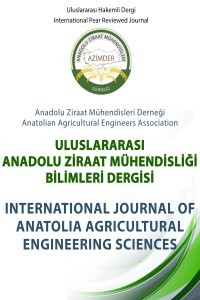Litter Materials in Poultry Industry
Poultry sector or in other words the poultry meat sector, is also developing rapidly in Turkey. With this development, the positive and negative environmental impacts of the wastes, which are produced during production in the sector and evaluated as by-products, have started to attract more attention day by day. Due to the high amount of production, the economic value, the high mineral content and the high cost of alternative implementation, litter materials, which are considered as waste by some circles, should not be harmful to the environment and should be reintroduced into economy or production. This issue is even more important in terms of tourism of the country. It is thought that developments that will please all parties by working in close cooperation supported by all stakeholders and public in the sector, especially official organisations, private sector and universities would solve the issue soon
Anahtar Kelimeler:
Poultry, poultry meat
___
- Anonymous, 2004a. Regulation (EC): 852/2004.The Hygiene of Foodstuffs.
- Anonymous, 2004b. Regulation (EC): 853/2004. Specific Hygiene Rules for Food of Animal Origin.
- Anonymous, 2004c. Regulation (ECE): 854/2004. Specific Rules For The Organisation Of Official Controls On Products Of Animal Origin Intended For Human Consumption.
- Anonymous, 2010. Veterinary Services, Phytosanitary, Food And Feed Law. Law No: 5996. Official Newspaper, No: 27610, 13 June 2010. Ankara, Turkey.
- Anonymous, 2011. Regulation on Animal By-Products Not Used for Human Consumption. Official Newspaper, No: 28152, 24 December 2011.Ankara, Turkey.
- Anonymous, 2018. Ross BroilerManagement Handbook. Aviagen Group. Alabama, USA.
- Bilgili,S.F., J.B.Hess, J.P. Blake, R.A.Norton, K.S.Macklin and E.A.Guertal, 2004. “Rearing Broilers on Sand: A Result Demonstaration Project” XII. WPC, İstanbul.
- Demirulus H. and A. Aydın, 1996. Reducing Environmental Pollution by Processing Poultry Wastes and Waste Materials.Journal of Ecology and Environment (19):22-26.
- Kacar B. andV. Katkat, 2009. Fertilizers and Fertilization Techniques (3rd Ed.)Nobel Publications (1119):17-54.
- Kelleher B.P., J.J.Leahy, A.M. Henihan, T.F. O’Dwyer, D. Sutton and M.J. Leahy, 2002. Advances in Poultry Litter Disposal Technology – A Review, Bioresource Technology (83):27–36.
- Khosravinia H. and Azarfar, 2004. “ Evalution of Corn-based Plant By-products and Dreid Rumen Contents as Broiler Litter under Heat Stress Condition”. XII. WPC, İstanbul.
- Koca S., 2015. BESD-BİR Sector Report: Production, Consumption, Export, Problems, Solutions and Opportunities. BESD-BİR Publications No: 14. Ankara, Turkey.
- Lacy, M.P. 1991.Litter Quality and Broiler Performance. Universtiyof Georgia Coop. Ext. Serv. Pub. No. L426-W.
- Moore P.A. Jr., T.C. Daniel, A.N. Sharpley and C.W. Wood, 1998. Poultry Manure Management, Chapter (3):60-75.
- Taban S., 2007. Importance of Broiler Fertilizers and Their Use in Agricultural Production.Uses of Broiler Fertilizers, Evaluation Methods and Legal Practices.Poultry R&D Publications (13):17-46, Bolu, Turkey.
- Yaldiz G., M. Çamlıca, S.A. Eratalar, M. Kulak, 2017. The Effects of Different Kıbele Fertilizer Applications on Yield of Sweet Basil (Ocimumbasilicum L.). Iğdır Univ. J. Inst. Sci. & Tech. 7(1): 363-370.
- ISSN: 2667-7571
- Başlangıç: 2019
- Yayıncı: Anadolu Ziraat Mühendisleri Derneği
Sayıdaki Diğer Makaleler
Productivity Of European Grapes Clones In The Conditions Of Atu Gagauzia
Natalia SUCMAN, Vsevolod POGREBNO, Veceslav BOLDESCU, Fliur MACAEV
Elma Yetiştiriciliğinde Meyve Kalitesi Üzerine Polinasyonun Etkisi
Turan KARADENİZ, P.nazlı CANVERDİ
Litter Materials in Poultry Industry
Nezih OKUR, Sabri Arda ERATALAR
Conservation Of Plant Genetic Resources For Rare And Endangered Species In Turkey
Noreen ASLAM, Cisem Nildem DOGAN, Ferdi AGIL, Huri Melek YAMAN, Nusret ZENCİRCİ
